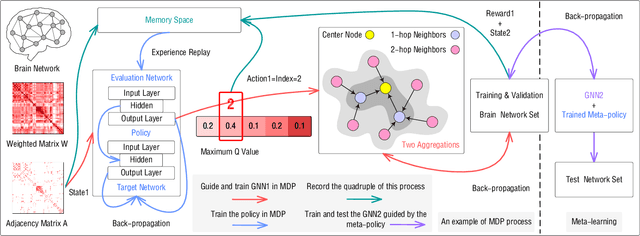Jessica Monaghan
Deep Reinforcement Learning Guided Graph Neural Networks for Brain Network Analysis
Mar 18, 2022



Abstract:Modern neuroimaging techniques, such as diffusion tensor imaging (DTI) and functional magnetic resonance imaging (fMRI), enable us to model the human brain as a brain network or connectome. Capturing brain networks' structural information and hierarchical patterns is essential for understanding brain functions and disease states. Recently, the promising network representation learning capability of graph neural networks (GNNs) has prompted many GNN-based methods for brain network analysis to be proposed. Specifically, these methods apply feature aggregation and global pooling to convert brain network instances into meaningful low-dimensional representations used for downstream brain network analysis tasks. However, existing GNN-based methods often neglect that brain networks of different subjects may require various aggregation iterations and use GNN with a fixed number of layers to learn all brain networks. Therefore, how to fully release the potential of GNNs to promote brain network analysis is still non-trivial. To solve this problem, we propose a novel brain network representation framework, namely BN-GNN, which searches for the optimal GNN architecture for each brain network. Concretely, BN-GNN employs deep reinforcement learning (DRL) to train a meta-policy to automatically determine the optimal number of feature aggregations (reflected in the number of GNN layers) required for a given brain network. Extensive experiments on eight real-world brain network datasets demonstrate that our proposed BN-GNN improves the performance of traditional GNNs on different brain network analysis tasks.
A Survey on Deep Learning based Brain Computer Interface: Recent Advances and New Frontiers
Jun 04, 2019



Abstract:Brain-Computer Interface (BCI) bridges the human's neural world and the outer physical world by decoding individuals' brain signals into commands recognizable by computer devices. Deep learning has lifted the performance of brain-computer interface systems significantly in recent years. In this article, we systematically investigate brain signal types for BCI and related deep learning concepts for brain signal analysis. We then present a comprehensive survey of deep learning techniques used for BCI, by summarizing over 230 contributions most published in the past five years. Finally, we discuss the applied areas, opening challenges, and future directions for deep learning-based BCI.
 Add to Chrome
Add to Chrome Add to Firefox
Add to Firefox Add to Edge
Add to Edge